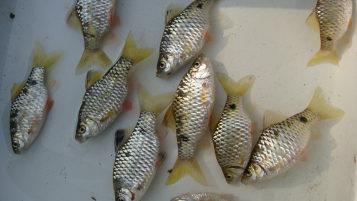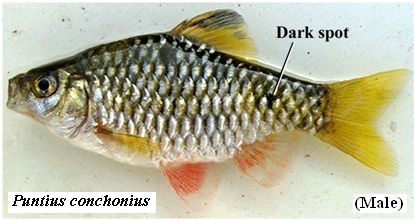Sort out small sized fishes with a prominent BLACK BLOTCH at the base of caudal fin, along with one behind gill cover or one at the base of dorsal fin:
…………….place them labeled as Puntius sp. may be!
Live specimens of Puntius (=Pethia) sp. Mark the presence of a prominent black blotch on the caudal peduncle in most samples. While swimming one may also watch a black banded fish (Rasbora deniconius of Lot 5) and for a while a fish with an ocellus at the end of the long dorsal fin (young of Channa gachua or orientalis to segregated under Lot 10 of ‘Snake Heads or Murrels).
Usually, they are procured from slow running, marginal, shallow or weedy/swampy niches.
These medium-sized, somewhat diamond shaped, laterally compressed, brightly coloured, shining silvery fishes, having DARK BLACK BLOTCH (beauty-spot) at the base of caudal fin and / or just behind operculum and / or on the base of the dorsal fin, are supposed to belong to Genus – Puntius (= PethiaorSystomus).
This lot can now be segregated into at least 5 species, as represented in the stream of Doon Valley (other places, too), on the basis of the following diagnosis.
- Barbels absent and osseus dorsal fin ray serrated:May be P. (Pethia) conchonius or P. (Pethia) ticto to be distinguished as follows:
P. conchonius has been found to be the most dominant species amongst all Puntiussp., frequent at the weedy downstream sections along with shoals of P. ticto which is the second most dominant species. In both, barbels are absent, dorsal fin ray is long and serrated posteriorly. The Lateral line ceases after 7th and 8th scale and a dark spot (BLACK BLOTCH) is present on the caudal peduncle covering 18th– 22nd scales along lateral line. Both can be easily segregated primarily on the basis of bright colourations of P. conchonius, the whole colouration of the body presenting a yellowish – silvery hue and males being more brightly coloured and slimmer with upper terminus of dorsal fin edged black, lemon pectoral fins, reddish based ventral and anal fins. Females on the other hand are deep-bodied with dorsal fin terminus similarly edged black; ventral and anal fins being also reddish at bases but tipped blackish. In both the cases caudal fin is bright lemon yellow.
In case of P. ticto, body is uniform bright silvery and its depth of body ranges from 2.4 -2.9 times in SL (Standard Length) as compared to 2.2 – 2.5 in P. conchonius.
Live specimens of Puntius (=Pethia) sp. It will be fascinating to watch a fish swimming in front; mark its dorsal fin with serrated undivided fin ray (identified as Puntius [=Pethia] ticto).
- 2 pairs of barbels and osseus dorsal fin ray serrated: P. (Systomus) sarana .
P. Sarana is the largest (80 – 90 mm TL [Total Length] , 61 – 71mm SL ) of all Puntius sp. with longer and 2 pairs of quiet prominent barbels, finely serrated dorsal fin spine , complete lateral line with 30 – 33 scales along it, in contrast to 22-27 in P. sophore and 26 -28 in P. chola.
Opercles are shot golden. Fins greyish with caudal, pelvic and anal fins having reddish tinge. Youngs have a faint black spot at the base of caudal peduncle (covering about 26 – 28th scales)
• Barbels absent but the osseus dorsal fin ray weak and entire: Puntius sophore !
P. sophore can be readily identified on account of the presence of a diffused black blotch at the base of caudal (covering 21-22 scales and partly covering 6-7 surrounding scales) and similarly diffused one at the base of the dorsal. Fins are tinged orange at the tips. Pecorals yellowish. Most prominently, large specimens (70 – 95 mm) show the presence of a scarlet- red lateral band extending from behind the operculum to the base of caudal fin, the continuity becoming obvious up to the fork of the fin. After preservation , the scarlet red band gradually fades-out , otherwise there remains a faint blackish band.
- 1 pair barbel but the osseus dorsal fin ray entire: Puntius chola !
P. chola is different from all the above referred species in having 1 pair barbel, entire osseous dorsal fin ray, opercle shot with gold and purple, a transverse black band across the middle of the dorsal fin, behind the opercle and at the base of caudal. The males have orange anal and pelvic fins as compared to light coloured fins in female.
- Systematic position
Family: Cyprinidae
Subfamily: Barbinae - Accepted Synonyms:
Puntius conchonius = Pethia conchonius
Puntius ticto = Pethia ticto
Puntius sarana = Systomus sarana - Good for aquaria
Compilation by Dr. SK Gupta.
Instant Identification of Indian Freshwater Fish in the Field









